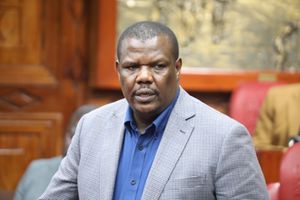Happening Now: LIVE: Agriculture CS Mithika Linturi's impeachment trial
Kenya’s internet bandwidth up 20pc on cable upgrade

A worker lays a fiber optic cable in Nyeri town on August 18, 2020. Kenya’s internet bandwidth increased by 20.4 per cent in the three months to June.
Kenya’s internet bandwidth increased by 20.4 per cent in the three months to June after a major upgrade of the capacity of one of the main fiber-optic undersea cables landing in the country, paving the way for faster internet speeds and reliable connectivity.
The Communications Authority of Kenya (CA) says total international internet bandwidth available in Kenya grew to 14,413 gigabits per second (Gbps) between January and March up from 11,970Gbps in the preceding quarter.
The higher bandwidth follows the upgrade of the capacity of the East African Marine System (TEAMS) fiber-optic undersea sea cable. TEAMS is one of the six undersea cable landings in Kenya.
Others are SEACOM, EASSy, LION 2, DARE 1, and PEACE.
“During the reference period, the total international internet bandwidth available in the country grew by 20.4 per cent to 14,413.053Gbps. The increase is due to capacity upgrade on the cable by TEAMS during the period,” says CA.
The 5,000-kilometre TEAMS links Mombasa to Fujairah in the United Arab Emirates (UAE).
The cable, whose construction began in January 2008 and was completed in June 2009, was built as a joint venture between the government of Kenya and Kenyan operators, who hold 85 per cent shares, and UAE-based operator Etisalat, with 15 percent.
The recent upgrade saw its bandwidth capacity jump by 151.1 percent from 1,618Gbps to 4,063Gpbs enabling it to surpass SEACOM to make TEAMS the second largest fiber-optic cable landing in Mombasa.
“As seen during the referenced period, TEAMS upgraded their cable of the available bandwidth to meet the consumers’ needs as the demand for data/Internet services steadily increases,” said CA.
The 10,000km Eastern Africa Submarine System (EASSy), which has nine landing stations in Sudan, Djibouti, Somalia, Kenya, Tanzania, Comoros, Madagascar, Mozambique, and South Africa, is the largest undersea cable connecting to the country.
It has a capacity of 4,990Gbps.
Meanwhile, SEACOM, LION 2, and DARE 1 have capacities of 3,920Gbps, 571.5Gbps, and 866.04Gbps respectively.
Telkom Kenya owns a 23 percent stake in TEAMS, a 10 percent stake in LION 2, and a 2.6 percent stake in EASSy.
The upgrade of TEAMS comes at a crucial time when demand for internet services is rising rapidly both in Kenya and globally as more new users get connected to the internet as well as increased digitization of services such as e-commerce, remote working and learning as well as financial services.
During the quarter, for instance, the total utilized internet bandwidth grew by 25.5 percent signaling higher internet activity during the period.
The CA data shows undersea cable bandwidth sold in Kenya during the quarter to March rose to 5,161Gbps up from 4,361Gbps while bandwidth sold in other countries grew to 2,953Gbps from 2,105Gbps in the previous quarter.
This comes as communications service providers have embarked on expanding and upgrading their network infrastructure to meet the growing demand for mobile voice and data services.
“Noting that there has been a tremendous shift from voice to data, new projects have been initiated including rural tower expansion, 4G, 5G, and fiber infrastructure rollout,” said CA.





